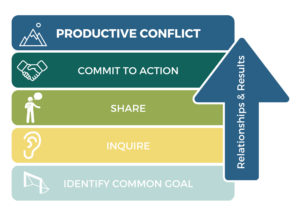When you’re in the middle of a conflict, it’s easy to react emotionally and make detrimental mistakes. This is why it’s important to pause and be intentional with a productive approach instead.
Let’s take a look at some big mistakes that happen often during conflict conversations through an example scenario.
Sandra’s Conflict Conversation
Sandra was livid. She had worked for weeks on her presentation, confident it would provide an opportunity to showcase her expertise and gain the attention of her department head. But mid-way through delivery, in front of the entire department, Tony chimed in with an “innocent question” that Sandra felt undermined her credibility. If looks could kill…
She tossed and turned that night thinking about the words she would have with Tony. She’d make sure he understood how badly he’d damaged her reputation. He owed her an apology and needed to promise never to do that again!
The next morning, Sandra stormed into Tony’s office demanding a conversation. She proceeded to tell Tony how wrong he was for what he did. When he tried to speak, she cut him off – no excuses! Dumbfounded, Tony could do nothing but apologize. Sandra told him to never humiliate her like that again, and stormed out – satisfied that she’d put Tony in his place. “Success! That went exactly as planned,” she thought to herself. And the two of them never spoke to each other again.
What Went Wrong?
Sandra fell into the trap of 3 big mistakes people make when engaging in a high-stakes conversation where there are differing opinions and emotions are strong.
| 1. She entered the conversation with only her goal in mind. To put Tony in his place. |
| Identifying a COMMON GOAL that serves both parties removes the argument from the conversation, allowing for a productive two-way dialogue. |
| 2. She jumped right to sharing her perspective. This put Tony on the defensive and didn’t allow him to explain his own perspective. He shut down. |
| It’s important to INQUIRE first and then share in order for the other person to engage and add to the pool of information and understanding. In fact, the majority of a productive conflict conversation is dedicated to inquiry! |
| 3. They didn’t agree on next steps. Instead, Sandra dictated what was to happen with no plan to follow up. Their relationship was permanently damaged. |
| After you inquire and share (and inquire some more!), COMMIT TO ACTION that serves the common goal, agreeing on who will do what and how the parties will follow up. |
Productive Conflict

Productive Conflict is a skill that can be learned! This model helps strengthen relationships and drive the desired results.
In our blog Productive Motives: A Powerful Tool in Productive Conflict, we explore the importance of shifting to productive motives before engaging in a conflict conversation. You can also learn more about our Productive Conflict program here.






